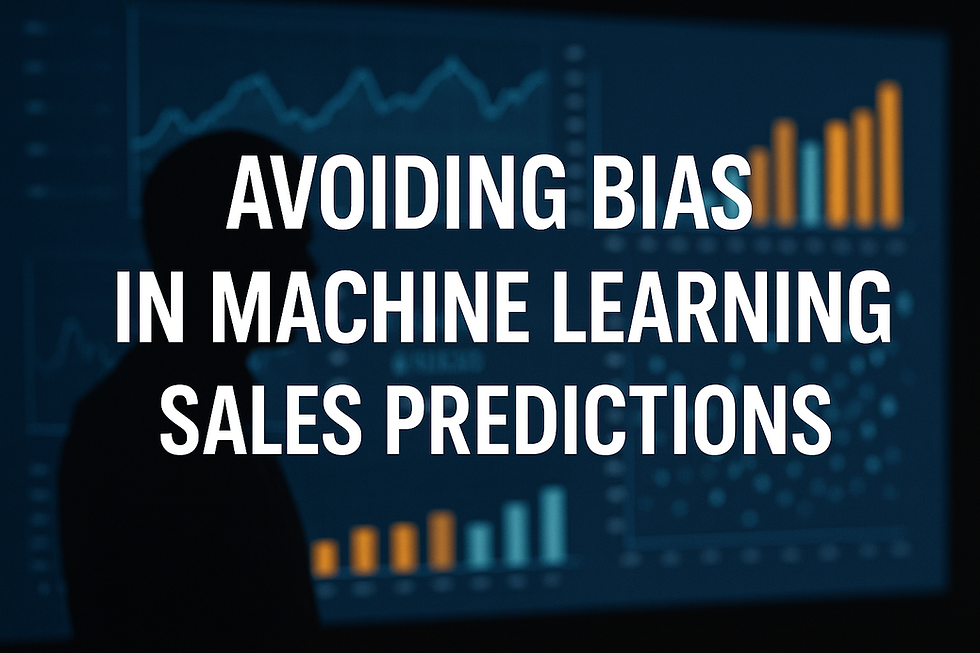Building High Quality Sales Datasets for Machine Learning
- Muiz As-Siddeeqi

- Aug 20
- 6 min read

Building High Quality Sales Datasets for Machine Learning
The Brutal Truth About Machine Learning in Sales: It’s Only as Good as Your Data
Before we dive into anything technical, let's face the raw truth head-on. No matter how advanced your machine learning model is... no matter how much you invest in AI tools... no matter how cutting-edge your predictive analytics seem... if your sales data is messy, incomplete, biased, or inaccurate — your model will fail. Period. It won’t just perform poorly. It will give misleading results that could hurt your revenue, damage your customer experience, and derail your entire sales strategy.
In sales, data is not just the new oil. It’s the engine, the fuel, and the entire ecosystem. And building high quality sales datasets for machine learning isn’t just a best practice anymore. It’s an existential need if you're serious about scaling with AI, staying competitive, and making confident, data-driven decisions.
This blog is for founders, sales ops, data scientists, growth marketers, AI engineers — anyone who wants to actually make machine learning work in sales. Not in theory. In real life. In real revenue.
Let’s get brutally honest, deeply technical, and incredibly real.
Bonus: Machine Learning in Sales: The Ultimate Guide to Transforming Revenue with Real-Time Intelligence
Why Most Sales Data is Garbage: A Cold Industry Diagnosis
According to Gartner’s 2023 report on Sales AI Readiness, over 72% of sales teams use datasets with missing or outdated fields in their ML workflows. A study by Experian also revealed that 29% of businesses believe their customer data is inaccurate, and 44% of sales teams waste time on incorrect lead data (Experian Global Data Management Report, 2023).
Why is this happening?
Manual Entry Errors: CRMs like Salesforce, Zoho, and HubSpot still depend heavily on reps manually entering data. Typos. Missed fields. Wrong timestamps. Duplicates.
Data Silos: Sales data lives in CRMs, emails, call recordings, spreadsheets, marketing automation tools, and ERP systems. These aren’t synchronized.
Inconsistent Labeling: Different teams use different definitions for lead stages, funnel stages, or opportunity status.
Biased Sampling: Only successful deals may be logged in detail; failed interactions often go undocumented.
No Data Governance: Companies operate without any centralized policy for what counts as “valid” or “clean” sales data.
This creates what we call the dirty dataset trap — and it’s the silent killer of AI models in sales.
What “High Quality Sales Data” Actually Means — And Why It's So Rare
A high quality sales dataset must meet several strict criteria:
Accuracy: Every record must reflect the real-world sales interaction.
Completeness: All necessary fields are filled — including call notes, timestamps, intent signals, buying stage, etc.
Timeliness: Data must be current. Outdated leads or customer stages ruin training outcomes.
Consistency: Same format, same definitions across the board.
Relevance: No bloated logs or irrelevant metadata. Just what helps predict outcomes.
Label Integrity: Are your conversions, churns, renewals, and closes marked properly — and verified?
This sounds obvious. But let’s bring in an eye-opening stat:
According to the Harvard Business Review (HBR, 2017), bad data costs U.S. businesses more than $3 trillion annually. And the top culprit? Customer and sales data.
What Types of Sales Data Matter Most for Machine Learning?
Now let’s get practical. If you're building a sales ML pipeline, here’s what really matters.
1. Lead and Prospect Data
First-party: From website forms, emails, demos
Third-party: From tools like ZoomInfo, Clearbit, LinkedIn
What matters: Source, firmographics, engagement score, first contact timestamp, sales stage history
2. CRM Pipeline Data
Opportunities
Deal stages
Forecast entries
Lost reason (if available)
Closed-won/closed-lost date
3. Activity Data
Email opens, replies, click-throughs (from tools like Outreach, Salesloft)
Call logs and transcripts (with metadata like call length, sentiment scores)
Meeting recordings
Chatbot interactions
Time between touches
4. Revenue Data
ARR, MRR, renewal dates
Discounts offered
Cross-sell/Upsell history
Churn reasons
5. Behavioral and Intent Signals
Page visits
Downloads
Form fills
Webinar attendance
Tool usage post-purchase (from product analytics)
6. Time Series Features
How long did it take to convert?
How frequently did they respond?
What day/time were most meetings booked?
7. Territory and Team Mapping
Which rep handled the lead?
What region or vertical?
What type of outreach did they use?
High quality ML sales datasets are not flat CSVs. They’re dynamic, multi-layered, and contextualized.
How the Best in the Industry Build High Quality Sales Datasets (Real Case Studies)
1. HubSpot’s Unified Dataset Approach
HubSpot consolidated over 20 different internal tools, marketing sources, and CRM activities into a single customer data layer (Source: HubSpot Engineering Blog, 2022). They introduced a unified event tracking system that helped them:
Reduce ML data prep time by 70%
Improve their lead scoring model accuracy by 32%
Identify duplicate or conflicting signals across different platforms
They used tools like Apache Kafka, dbt, and Snowflake for real-time stream processing and warehouse syncing.
2. Outreach’s ML Pipeline on Sales Activities
Outreach.io, a major sales engagement platform, developed a machine learning model to predict deal success based on rep activities. But it wasn’t possible without first building a clean dataset of over 400 million sales activities (Source: Outreach Engineering, 2021).
They focused on:
Normalizing subject lines, call lengths, sentiment scores
Removing noisy or irrelevant activity types
Time-weighting interactions (recency mattered more)
That dataset is now used across their predictive engagement tools.
3. Zendesk’s ML Sales Forecasting via Looker + BigQuery
Zendesk’s GTM teams partnered with their data science division to forecast quarterly sales using ML. But their first models failed.
The issue? The “closed-won” status was being updated retroactively, not in real-time.
They fixed this by integrating timestamped audit trails, improving model F1 score by 23% (Source: Zendesk Data Science Case, 2020).
How to Build Your Own High Quality Sales Dataset: Step-by-Step Blueprint
We’ve built this framework from real-world consulting work and documented ML pipelines from B2B SaaS teams.
1. Data Audit and Discovery
Map all sources: CRM, marketing automation, chat logs, ERP, billing, support
Run exploratory data analysis: Missing fields, distribution anomalies, invalid types
2. Centralization
Use ETL/ELT tools (Fivetran, Airbyte, Stitch) to bring data into one data warehouse (BigQuery, Redshift, Snowflake)
Use dbt for modeling and transformations
3. Data Cleaning & Standardization
Use open-source tools like Great Expectations or Soda to run data quality checks
Define standard formats (date, phone, industry, etc.)
Build rules for deduplication and validation
4. Labeling and Target Variable Definition
Ensure every record is clearly labeled: win/loss, upsell, churn, renewal
Automate label validation through scripts, audit logs, human review
5. Feature Engineering
Create calculated fields: email response time, call frequency, deal velocity
Bucket values (small/medium/enterprise, high/low intent)
Normalize and scale features for ML input
6. Metadata & Time Awareness
Log data update time
Include historical context (not just current values — use delta tracking)
7. Ongoing Quality Monitoring
Build dashboards to track missing fields, update delays, and field consistency
Run alerts for data drift (e.g., sudden drop in form fills)
Real Tools That Help in Building Sales ML Datasets
These are real tools used by companies to manage their sales data quality:
Common Mistakes That Destroy Sales Datasets for ML
Using static exports instead of dynamic pipelines
Mixing training and future data (data leakage)
Not timestamping updates
Failing to document data lineage (where each value comes from)
Skipping post-training validation with real closed deals
Ignoring edge cases (e.g. very large deals, unusually fast closes)
The Emotional Cost of Bad Data: Wasted Work, Broken Trust, Missed Growth
It’s not just numbers. It’s morale. Teams build models. Leadership expects results. But if the dataset is flawed from the start, it’s not just a tech failure. It becomes a credibility crisis.
We’ve seen teams abandon ML altogether after one bad dataset-led project. Not because ML doesn't work. But because their foundation was rotten.
Sales reps lose trust in forecasts. Ops lose faith in automation. Founders pull back funding from AI pilots.
This damage is very real — and completely avoidable.
Final Thoughts: Treat Your Sales Data Like a Product
Your dataset is not just a CSV. It’s an asset. It needs version control, QA, audits, feedback loops, and ownership.
Want real results from machine learning in sales?
Then first, earn the right to build the model.
By building a dataset that’s accurate, complete, verified, clean, and relevant — you do more than prepare your AI for success.
You protect your team from failure.
You protect your business from blind decisions.
And you finally give machine learning in sales the chance it deserves.
Let us repeat what every seasoned AI team learns the hard way:
Your ML model is only as good as your worst column.

$50
Product Title
Product Details goes here with the simple product description and more information can be seen by clicking the see more button. Product Details goes here with the simple product description and more information can be seen by clicking the see more button

$50
Product Title
Product Details goes here with the simple product description and more information can be seen by clicking the see more button. Product Details goes here with the simple product description and more information can be seen by clicking the see more button.

$50
Product Title
Product Details goes here with the simple product description and more information can be seen by clicking the see more button. Product Details goes here with the simple product description and more information can be seen by clicking the see more button.






Comments